American Bank Note Company print runs
The American Bank Note Company engraved several special vignettes: a portrait of Mariano Escobedo (C 232)Mariano Escobedo was born in 1826 in the city of Galeana, Nuevo León. When the U.S. invasion took place, he enrolled in the army. In 1855, in the Revolution of Ayutla, he took up arms as Captain of a company that he formed himself and fought in Nuevo León, Zacatecas and San Luis Potosí.
When the French intervention began, he organized a brigade and joined the Army of the East in Acultzingo. He was awarded the rank of Brigadier General for the important part he played in the Battle of Puebla on 5 May 1862. He participated in the siege of Puebla in 1863 and though he was taken prisoner, he managed to escape and fled to Orizaba where he joined Porfirio Díaz and helped him organize the Army of the East. When Oaxaca fell, he headed toward the border, formed the Army of the North and started recovering a great deal of Mexican territory. He defeated the French in Santa Gertrudis and continued his march toward the South, besieging Maximilian in Querétaro. This deed prompted Benito Juárez to name him Commander in Chief of the army. After several battles, he took Querétaro at the head of the Republican troops on 15 May 1867. He held the post of Governor of San Luis Potosí and Nuevo León, President of the Supreme Court of Military Justice and Minister of War in 1876.
He died in Tacubaya, Mexico City in 1902. for all the faces, a mountain peak (C 717) for the $5 note, the Estación del Golfo railway station in Monterrey (C 721) for the $10, the cathedral in Monterrey (C 720) for the $20, the theatre in Monterrey (C 722) for the $50, the Municipal Palace (C 718) for the $100 and the Government Palace (C 724) for the $500.
The company began producing models for the $5, $10, $20, $50 and $100 notes on 29 May 1899 and these, and the model for the $500, were approved on 30 October. A two page summary listed the following corrections:
$10: Place the “19” – 1/8 of an inch to the left.
$50: Erase the advertisement which is posted against the column in the centre; the man who is at the following one, to the right; the man and the post which are at the right of the Juarez Theatre; and the man who is on the left of the same engraving – that of the Theatre Juarez.
$100: Erase the post which is at the right of the engraving or vignette, as well as that which is in the centre with a man up on it. Run the statue over to the left, so that a clear space shall be symmetrical with the cathedral tower which is on the right, even though all or part of the house on the left should disappear. Done!
$500: The column on the front of the centre of the edifice should stand out; these form a portico which is advanced to the front, and make the windows appear in the four spaces which now are in blank.
BACK: As in this vignette there appears a great open space towards the top, it would be well to put in the lower part of the mountain a rising sun, as is sketched on the note of $500; or a full moon in the midst of clouds.
There were secret countersigns on all the notesABNC, folder 179, Banco Mercantil de Monterey (1909-1933)
The original plates had the titles "GERENTE", "PRESIDENTE" and "INTERVENTOR DEL GOBIERNO" and the text included "EN MONEDA DE PLATA".
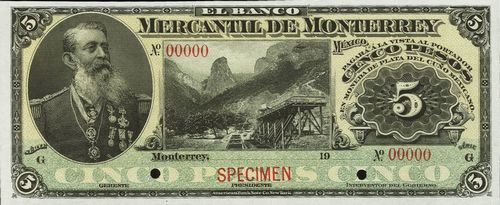
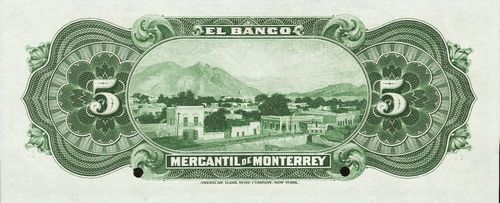
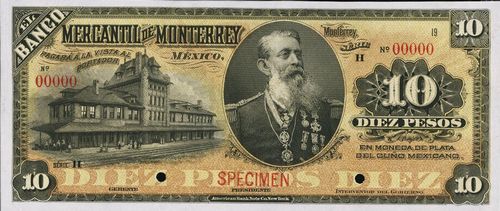
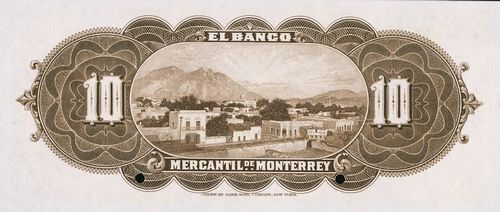
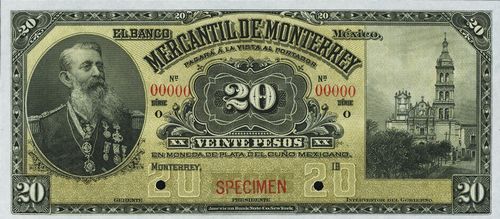
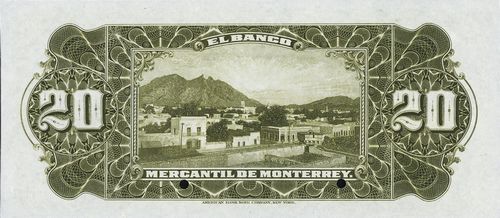
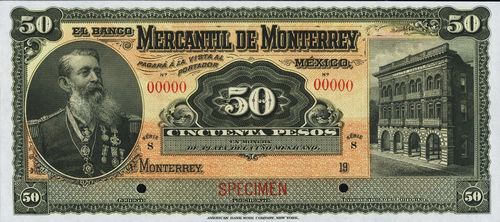
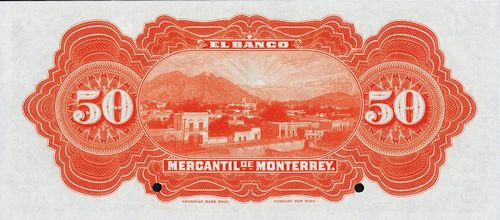
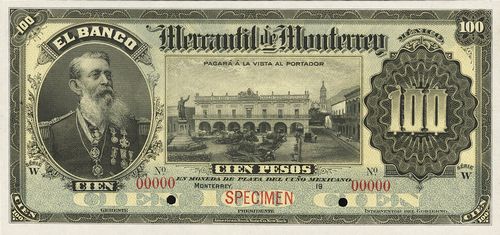
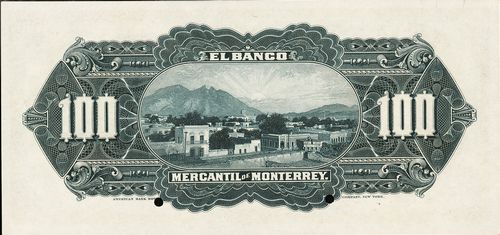
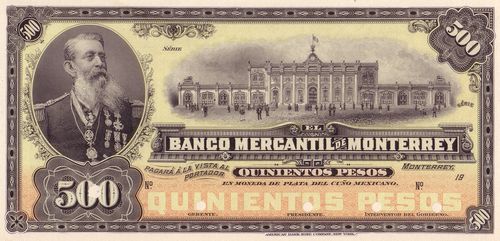
| Date | Value | Number | Series | from | to | Comment |
| October 1899 | $5 | 70,000 | A-G | 1 | 70000 | Series changed every 10,000 notes |
| $10 | 35,000 | H-N | 1 | 35000 | Series changed every 5,000 notes | |
| $20 | 20,000 | O-R | 1 | 20000 | Series changed every 5,000 notes | |
| $50 |
8,000 | S-V | 1 | 12000 | Series changed every 2,000 notes | |
| $100 |
2,500 | W-Y | 1 | 2500 | Series changed every 1,000 notes | |
| $500 | 500 | Z | 1 | 500 |
For the subsequent runs the title "PRESIDENTE" was altered to "CONSEJERO", the text to "EN MONEDA CORRIENTE" and "MONTERREY" and "19" erased.
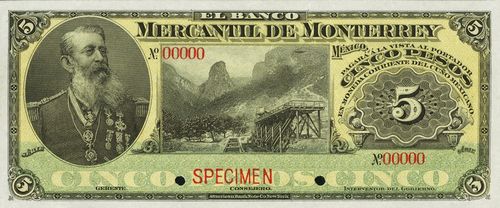
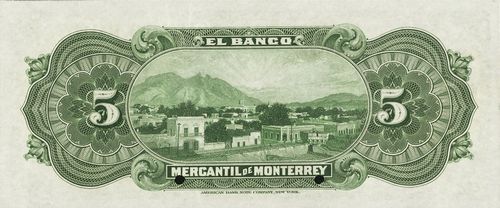
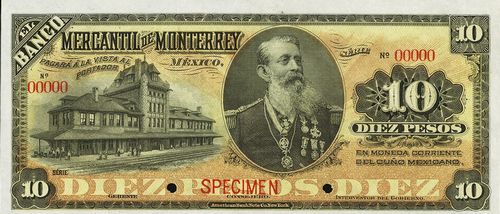
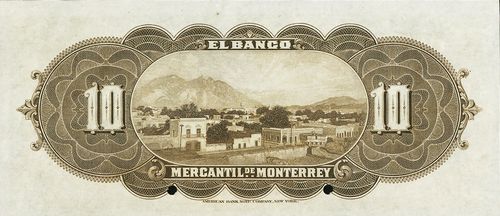
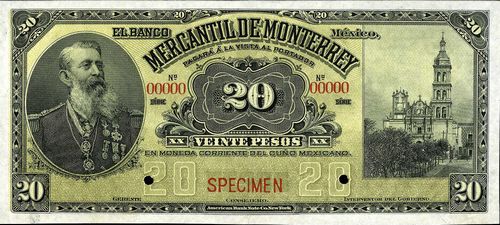
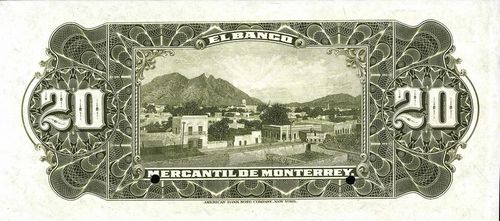
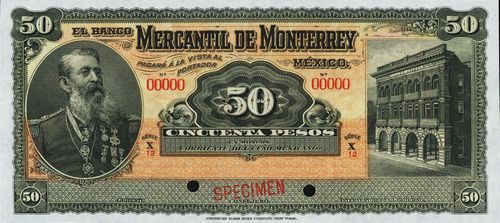
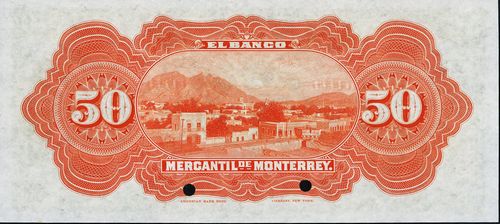
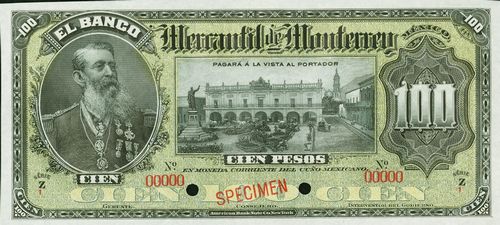
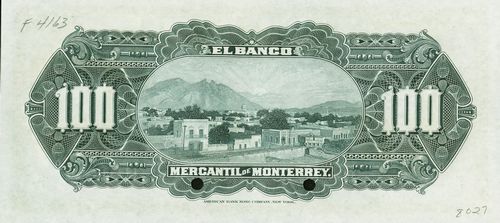

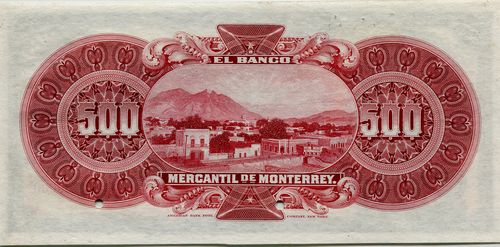
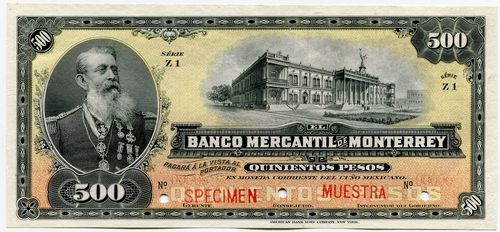
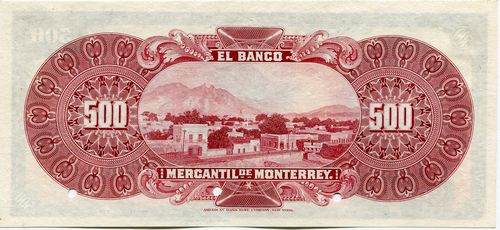
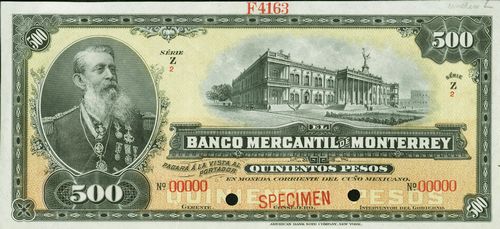
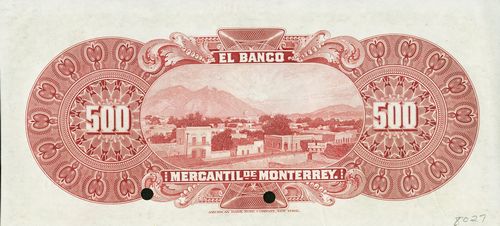
| Date | Value | Number | Series | from | to | Comment |
| June 1906 | $5 | 40,000 | H-K | 70001 | 111000 | Series changed every 10,000 notes |
| $10 | 30,000 | O-Q | 35001 | 65000 | Series changed every 10,000 notes | |
| $20 | 20,000 | S-T | 20001 | 40000 | Series changed every 10,000 notes | |
| $50 |
10,000 | W-X | 8001 | 18000 | Series changed every 5,000 notes | |
| $100 |
4,000 | Z | 2501 | 6500 | ||
| $500 | 400 | Z1 | 501 | 900 |
On 8 June 1910 the bank asked for price and delivery for 60,000 $5 and 20,000 $10 notes. On 15 June the ABNC quoted a price of $1,873.90 U. S. Gold, F.O.B. New YorkThe price was later increased to $2,000 because the bank wanted an additional number below the series letter, which necessitated 80 changes during printing and on 20 June delivery within three months, citing “The reason for this apparent delay is due to the fact that the plates which have heretofore been used in the printing of these denominations are somewhat worn out, and it will be necessary, before beginning the printing, to spend quite some time in retouching the same, in order to give you the best work.”ibid..
| Date | Value | Number | Series | from | to | Comment |
| July 1910 | $5 | 60,000 | L-Q | 111000 | 170000 | Series changed every 10,000 notes |
| $10 | 20,000 | R-S | 65001 | 85000 | Series changed every 10,000 notes |
The whole order was forwarded, by Wells Fargo Express, on 18 October 1910, and received by 29 October.
On 26 March 1914 José L. Garza, the manager of the bank, wrote from Laredo, Texas, desperately asking for 112,500 notes in six denominations. The reason that the bank needed the notes was because in November 1913 they had been compelled to burn all the bank notes that they had in stock, owing to the fact that Monterrey was threatened with attack by the rebels.
The original request was for 50,000 $5 (R 170001-V 220000), 30,000 $10 (T 85001-V 115000), 20,000 $20 (T 25001-U 45000), 8,000 $50 (X 10001-Y 18000), 4,000 $100 (Z1 4501- Z4 8500) and 500 $500 (Z1 4501-Z4 8500). Note that the $50 notes were to change their serial letter every 4,000 notes.
The ABNC provided a price ($3,072.50 U.S. Gold. F.O.B. New York) and delivery (four to five weeks from order) on 1 April. “The time of delivery, when you take into consideration the fact that a number of the engravings are worn out and will have to be re-engravedHowever, on 6 April the Assistant Manager of Foreign Sales wrote “Although I fully appreciate that these plates are in poor condition, I have O.K.’d them for the present order since it will save time, and we shall be able to make better delivery to the bank. However, if you think it is absolutely impossible to print any of them, let me know and I shall order the necessary plates.”, is extremely good and we trust that your bank will realize that we are most desirous of being of assistance to you in your present predicament. If our quotation and promise of delivery are found acceptable we would thank you to furnish us with an official letter from the bank, confirming the order and give us the proper delivery instructions. We ask this so that our files may be complete and that we shall have the usual official order which it has been our custom to receive.” On 7 April Garza replied that communications with Monterey were cut off but as soon as traffic was reopened, he would send an official order from there. These terms were accepted on 4 April.
The day before, on 3 April, Garza had replied that, with an aim of reducing the cost, he was making a new request of another 56.200 notes, 20,000 $5 (X 220001-Y 240000) purposely missing the serial letter W, 20,000 $10 (X 115001-Y 135000) again missing the serial letter W, 10,000 $20 ( V 45001-55000), 4,000 $50 (Z 18001-22000), 2,000 $100 (Z5 8501- Z6 10500) and 200 $500 (Z7 1301-Z8 1400). He also asked that the numbers below the series letter be printed larger, to make the identification of deteriorated notes easier, and to give the $5 and $10 notes a larger marginHowever, on 23 April the ABNC replied “These notes, as you must understand, are printed so many on a sheet and our plates are prepared accordingly. For instance, the notes of 20 and 50 pesos denominations are 4 on a plate whereas those for 5 and 10 pesos are 8 on a plate. This is done in order to facilitate the printing and of course, upon completion of the work these notes are cut singly before they are shipped. From this you will see that in the present instance it is impossible to us to comply with your request and deliver the notes of 5 and 10 pesos with a larger margin, as it would mean that we would have to prepare new plates for these values, leaving more space between each note. We feel sure that you would not wish to go to this additional expense nor wait for the additional time that would be consumed in preparing these new engravings. Therefore, we are taking the liberty of furnishing you with these notes exactly the same size as before.
We have, however, made a note on our records and when the present engravings are worn out we will then take this matter up with you again and if you so desire, prepare our printing plates for the 5 and 10 pesos notes in order that we will be able to furnish them with a wider margin so that they will more equal in size the other denominations.". On 9 April the ABNC acknowledged the order, noting in passing “According to our records some numbers you call for, for the notes of 20. 50, 100 and 500 pesos denominations, are duplicates of notes previously furnished. We find that we are duplicating numbers as follows:-
15,000 - $20; notes, Nos. 25001-40000
8,000 - 50. “ Nos. 10001-18000
2,000 - 100. “ Nos. 4501-6500
200 - 500. “ Nos. 701-900
We suppose that the reason you call for these duplicate numbers is because you had to destroy the originals, as stated in your letter of March 26th. We would thank you to furnish us with a cremation certificate duly signed by the officials of the bank, stating that the above mentioned notes were cremated, in order that our records may be complete. We feel sure you understand why we ask for this certificate and that we simply need the same so that we can have the necessary document on file to prove that we are not furnishing duplicate bank notes. The ABNC also asked, due to the current circumstance in Mexico, for a payment in advance.
On 13 April Garza confirmed that “on the last days of February ult., we burned a large quantity of new notes, which were not yet authorised by the Secretary of the Treasury, neither with the signatures of the Directors of the Bank, nor with that of the comptroller of the Government, and although I do not remember the number of notes corresponding to each denomination, I know that the total amount represented by all these bills without authorization that were cremated, was $1,000,000.00 nominal value, and undoubtedly these notes must be the one showed in the records you hold.”
On 19 May Garza reported “After being besieged a long time by the rebels, the city of Monterey at last it fell in their hands on 24 April. Our Offices there were closed, having been able to take out from the city our valuable papers etc., and also our Cashier and Accountant succeeded in coming out from there and now are here in the United States, our bank having avoided in this way the prejudices it would have suffered undoubtedly, if they would have remained there.
These officers inform me that they never received the letters in which I gave them instructions to remit you $2,000.00, to send you a duplicate of the certificate that was drawn up when the notes to which I have made reference were cremated. They also say that they did not receive many other communications I sent them, owing to the fact that the railroads have been cut off and all the correspondence detained. The remittance of $2,000.00 was made to you because of my order by cable given to the Banco Central Mexicano, as I advised you in my letter dated 26 April.
As the actual situation in Monterrey has compelled us to modify in great part our projects, we will wait some time in order to send you the official order for the completion of the notes and the duplicate of the cremation certificate, advising you that, as I have expressed you in my previous letters, I find entirely justified your persistency in complying with these requirements.
In the meantime, I expect that you will continue with printing the bank notes, and as soon as you finish the order I request you to notify me in order to remit you the balance in your favour and determine what we deem convenient.”
| Date | Value | Number | Series | from | to | Comment |
| April 1914 |
$5 | 70,000 | R-Y | 170000 | 240000 | Series changed every 10,000 notes |
| $10 | 50,000 | T-Y | 85001 | 135000 | Series changed every 10,000 notes | |
| $20 | 30,000 | T-V | 25001 | 55000 | Series changed every 10,000 notes | |
| $50 | 12,000 | X-Z | 10001 | 22000 | Series changed every 5,000 notes | |
| $100 | 6,000 | Z | 4501 | 10500 | ||
| $500 | 700 | Z | 701 | 1400 |
By 19 September the ABNC had completed the printing of these notes but confirmed that they would not deliver them until they had received a proper official order from the bank and the cremation certificate covering the destruction of the former notes. The ABNC had also provided an invoice for the balance of $2,605 U.S. which Garza was having difficulty coveringOn 27 October Garza wrote” that the delay to answer you was due to the fact that I was trying to buy drafts for the mentioned amount in Monterrey, in the City of Mexico and here in Laredo, but at last I have not decided, until now, to buy same because the transaction is very expensive for the Bank, as our Mexican peso are quoted at 23¢ American gold at present. I have lately sold to the National Park Bank of that City, some funds in Germany and Spain and I am expecting to know in ten or twelve days in my drafts are honored, because on account of the financial difficulties which prevail in Europe, due to the actual war, there is no certainty in withdrawing the deposits held with Institutions of credit, but as soon as I receive notice of the payment of said drafts I intend to cover the balance of your invoice” but paid a few weeks later.
In August 1924 the ABNC asked the bank what should be done with the notes that it was still holding, and on 9 September the bank authorised their destruction. They were cremated on 11 November 1924.
The remaining plates used in printing these notesThe plates destroyed were:
1 – 8 on 5 pesos face plate made on order no. F 2573
1 – 8 on 5 pesos back plate made on order no. F 2573
2 – 1 on 5 pesos tints Nos. 1 & 2 made on order 10/28/99
1 – 8 on 10 pesos face plate made on order no. F 2573
1 – 8 on 10 pesos back plate made on order no. F 2573
2 – 1 on 10 pesos tints Nos. 1 & 2 made on order 10/28/99
1 – 4 on 20 pesos face plate made on order 10/28/1899
1 – 4 on 20 pesos back plate made on order 10/28/1899
2 – 1 on 20 pesos tints Nos. 1 & 2 made on order 10/28/99
1 – 4 on 50 pesos face plate #2 made on order No. F888
1 – 4 on 50 pesos back plate made on order 10/28/1899
2 – 1 on 50 pesos tints Nos. 1 & 2 made on order 10/28/99
1 – 1 on 100 pesos face plate made on order 10/28/99
1 – 1 on 100 pesos back plate made on order 10/28/99
2 – 1 on 100 pesos tints Nos. 1 & 2 made on order 10/28/99
1 – 2 on 100 pesos face plate made on order No. F 888
1 – 2 on 100 pesos back plate made on order No. F 888
2 – 1 on 100 pesos tints Nos. 1 & 2 made on order No. F 888
1 – 1 on 500 pesos face plate made on order 10/28/99
2 – 1 on 500 pesos tints Nos. 1 & 2 made on order 10/28/99
1 – 1 on 500 pesos back plate made on order 10/28/99
1 – 1 on 500 pesos face plate made on order No. F 888
1 – 1 on 500 pesos back plate made on order No. F 888
2 – 1 on 500 pesos tints Nos. 1 & 2 made on order No. F 888
were cancelled on 7 July 1931ABNC, folder 179, Banco Mercantil de Monterey (1909-1933).
